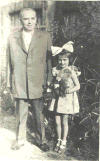In early 1945, when the tide of war was clearly turning against the Third Reich, several pregnant Jewish women managed to survive in the concentration camps, together with their newborns.4,16–19
A very special example was the “Pregnancy Unit” (Schwanger Kommando) in the Kaufering sub-camp of Dachau. Malnourished, exhausted, and low in weight, seven women with growing abdomens had not hid their secret. Surprisingly, they were not murdered. Instead, they were housed in a barrack and fed by a Jewish Kapo in charge of the kitchen. The Kapo recruited a Jewish obstetrician, a prisoner in the men’s camp, to perform the deliveries of the babies. The heroism of the mothers was complemented by the heroism of Dr. Erno Vadasz19 (personal communication from S. Magda to the authors, 2017) who is perhaps best remembered for these words, “too many Jewish children were killed, these must survive.”4,20
Early Life and Work
Erno Weisz was born in 1890 in the small Hungarian town of Nagykallo (
Figure 3). The son of the local butcher, he completed high school in 1908. Weisz then changed his name to Vadasz, to help avoid exclusion from his studies due to the “numerus clausus” code restricting Jewish students. He excelled in his studies and continued his education in the Medical Faculty of the University of Budapest, graduating in 1913.
 | Figure 3 The Synagogue in the Hungarian Town of Nagykallo, Hungary |
Soon after the start of his specialization, with the outbreak of World War I, Vadasz was conscripted into the Austro-Hungarian Army. After two months at the front, he was transferred for two years to a military hospital. Following his discharge from the Army, Vadasz completed his studies in obstetrics and gynecology. By 1930, he was well established and loved by the local population. He raised a family with his strictly orthodox wife and had two children.
Deportation to Kaufering
In 1944, the family was deported to Auschwitz. Vadasz was subsequently transported to Kaufering, a sub-camp of Dachau. There, he became emaciated and so weak that he needed a prop in order to stand.
In February 1945, Vadasz was called to the women’s “Pregnancy Unit” by the Kapo, David Witz. Although he needed help to stand, Vadasz demanded “soap, knife, hot water, towels,” as for any delivery.4,18–20 The mothers had been well fed before the deliveries, and within a few weeks Vadasz had successfully brought all seven babies into the world. This despite the fact that two of the deliveries were complicated. One mother was bleeding with a retained placenta that had to be manually extracted. During another delivery, the infant was lying in a breech position; the labor was prolonged and almost unsuccessful—with a leg presentation. As the delivery progressed, another mother promised to care for the baby if the mother died. Despite his own weakness, Vadasz applied all of his medical skills, and both mother and child survived.20,21
Following the deliveries, one of the mothers developed pneumonia. Vadasz sat next to her as she lay, semi-conscious for two weeks, and cared for both mother and child, sharing his own food until she recovered. Vadasz also managed to save a young girl from the crematorium, whom he recognized from his own town. The last baby he delivered was born one day after demolition of the crematorium, on April 29, 1945.21
In all, seven mothers were found by the liberating American Army, in satisfactory condition (see Figure 4).
 | Figure 4 Group portrait of five Hungarian Jewish mothers and their infants in a Dachau sub-camp in Germany |
After the War
Following the liberation, Vadasz learned that his entire family had been murdered. Vadasz was never rewarded or recognized for the lives of the babies he delivered (most English sources only refer to a Hungarian Jewish gynecologist who helped the mothers and delivered the babies
17). Anecdotal history, provided by the local Memorial Museum in Nagykallo (curator Mrs. Geza Harsanyi), suggests that Vadasz received false papers to leave the camp, accompanied by a supervising nurse. This is probable, perhaps as a reward for having successfully treated the commandant’s wife, but remains unverifiable, as it is unlikely that it would have been recorded in the camp diary (personal communication from S. Magda to the authors, 2017).
Vadasz returned to his hometown and restarted his practice; he was deeply loved and appreciated by the local residents (Figure 5). He married the supervising nurse from Dachau but refused to have children for fear of what might happen to them.5 He looked after the poor in the town and only charged what his patients could afford for his services.
 | Figure 5 Post-war Photo of Dr. Erno Vadasz with the Daughter of a Patient |
He passed away in 1957 from prostatic carcinoma. A small, unpretentious room in the local historical museum was established in memory of this dedicated Jewish physician.
All but one of the mothers survived to their eighties and all the children were alive as of 2018. The story of their survival, as well as the question of how such a sudden humanitarian event was allowed to happen in the vicious camp, is puzzling. It must have been a calculated move by the otherwise brutal commandant facing eventual future legal proceedings.17,20,21

 1* and Konrad Kwiet, Ph.D., Dr. Habil2,3
1* and Konrad Kwiet, Ph.D., Dr. Habil2,3